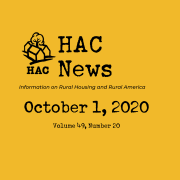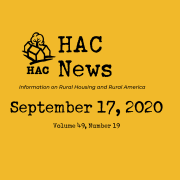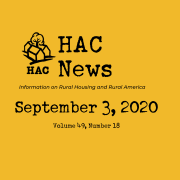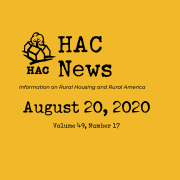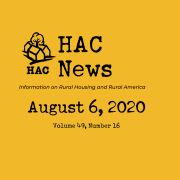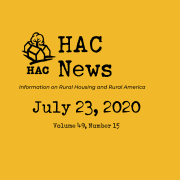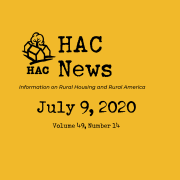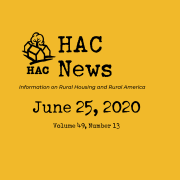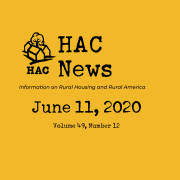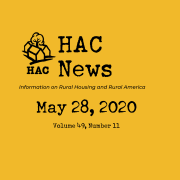HAC News: October 1, 2020
HAC News Formats. pdf
October 1, 2020
Vol. 49, No. 20
TOP STORIES
Federal funding continues through December 11.
A continuing resolution passed the House on September 22 and the Senate on September 30, then was signed into law by President Trump. It keeps the federal government running at fiscal year 2020 levels for most programs, including housing programs, through December 11. Congress will need to convene after the election to consider funding for the rest of fiscal year 2021.
Revised HEROES Act introduced in House.
The House may vote October 1 on a new version of the Health and Economic Recovery Omnibus Emergency Solutions (HEROES) Act, H.R. 8406. In May the House approved a coronavirus relief measure with the same name, H.R. 6800, that was never considered by the Senate. The revised bill would provide a total of $2.2 trillion in aid, compared to $3.4 trillion in the May HEROES Act and $300 billion in a September 8 Senate proposal. It would establish national moratoriums on renter evictions and homeowner foreclosures. Like the May bill, it would reopen the Paycheck Protection Program and add funds to a number of HUD programs, as well as $309 million for additional USDA Section 521 Rental Assistance. This RA would be available for tenants who are not currently receiving RA as well as those who are. The bill does not, however, include a provision in the earlier bill that would have allowed up to $25 million to be used for Section 542 vouchers.
Legal disputes continue over ending census count.
On September 24, federal judge Lucy H. Koh issued an injunction telling the Census Bureau not to end its decennial data collection on September 30. The Census Bureau appealed Koh’s ruling, then posted a one-sentence tweet and news release setting October 5 – rather than its previous October 31 deadline – as the “target date” to end data collection. Koh is now reportedly considering whether that announcement could constitute contempt of court. A Commerce Department Inspector General’s publication, as well as other reports, explain that ending the count early jeopardizes its accuracy.
Federal Reserve requests input on Community Reinvestment Act.
The Federal Reserve Board, one of the three federal banking regulatory agencies, has issued a notice asking for comments on revisions to its Community Reinvestment Act regulations. Responses will be due 120 days after the notice is published in the Federal Register. For more information, contact S. Caroline (Carrie) Johnson, Fed, 202-452-2762. The Office of the Comptroller of the Currency finalized a different CRA regulation in May. The third regulator, the FDIC, joined OCC’s initial proposal but not its final rule.
Native self-determination bill goes to President for signature.
The Practical Reforms and Other Goals to Reinforce the Effectiveness of Self-Governance and Self-Determination (PROGRESS) for Indian Tribes Act, S. 209, passed the Senate in June and the House on September 21. In addition to revising the Department of Interior’s process for approving self-governance agreements, the law will allow tribes participating in self-governance to assume some federal responsibilities with respect to construction projects.
OPPORTUNITIES
Community Connect broadband funds offered.
Nonprofits, for-profits, coops, state and local governments, and tribes can apply to USDA by December 23 for Community Connect grants to provide broadband service to underserved rural areas. For more information, contact USDA staff, community.connect@wdc.usda.gov, 202-720-0800.
HAC announces webinar on infill development.
Benefits of Infill Development: A Primer for Nonprofit Housing Developers will be offered on October 7. Successful infill development not only fills an empty lot with a new home. It also crafts a complete, well-functioning neighborhood with homes where resources are readily available and amenities are nearby, ensures the new development fits within the existing neighborhood context, and supports a cooperative partnership between government, community, financial institutions, nonprofits, neighborhood organizations and other stakeholders.
RuralSTAT
Seven states have more than 1 million rural homes as part of their housing stock. To view an interactive version of this map visit: https://arcg.is/0CGjD5

Source: Housing Assistance Council tabulations of the U.S. Census Bureau’s 2014-2018 American Community Survey. For more information on rural homes in your state, visit www.ruraldataportal.org.
CORONAVIRUS
Survey finds high levels of housing and food insecurity.
The Census Bureau’s Household Pulse Survey revealed that during the second half of August, 15% of renters were behind on paying their rent, according to the National Low Income Housing Coalition. The rates were even higher for Black, Latino and Asian renters, those with incomes below $35,000 and those who had lost employment income. In early September the Household Pulse Survey found that 10.5% of adults in the U.S. said their households did not have enough to eat during the past week, compared to 3.7% in a different pre-pandemic survey. Hunger was more common in households with children than in those without, according to the Center on Budget and Policy Priorities, which analyzed the data. Black and Latino families were more likely than others to lack sufficient food.
Data tool tracks economic impact of COVID-19.
The Opportunity Insights Economic Tracker, developed by economists at Harvard and Brown Universities, illustrates the economic impacts of COVID-19 on people, businesses and communities across the United States in real time. Rates of unemployment show that the pandemic is hitting low-income Americans the hardest. Data across all indicators is available by county and downloadable.
Materials posted on rural housing in the pandemic.
The recorded webinar (with subtitles available in English and Spanish) and slide presentation from Shelter in Rural Places: Facing Rural Housing Challenges in the Unfolding Pandemic are posted online. This session was the third Rural Opportunity and Development (ROAD) webinar co-designed and hosted by the Aspen Institute Community Strategies Group, the Housing Assistance Council, the Rural Community Assistance Partnership and Rural LISC.
REGULATIONS AND FEDERAL AGENCIES
Changes proposed for rural rental assistance and rental housing management.
USDA RD requests comments by November 23 on possible changes in the Section 521 Rental Assistance program, particularly regarding reuse of RA, and in the management of Section 515 and 514/516 properties. For more information, contact Jennifer Larson, USDA, 202-720-1615.
Comments requested on Duty to Serve plans for 2021.
The Federal Housing Finance Agency, which oversees Fannie Mae and Freddie Mac, is seeking public input on their 2020 and 2021 plans to support manufactured housing, affordable housing preservation and rural housing. Comments can be submitted online by October 23. Comments will also be accepted during virtual listening sessions on October 16 (manufactured housing), October 21 (affordable housing preservation), and October 23 (rural housing). Advance registration is required.
Proposed rule would expand and revise Family Self-Sufficiency program.
HUD’s proposal implements legislative changes to the FSS program, including expanding it to cover privately owned projects with project-based rental assistance as well as public housing. It also makes other changes intended to reduce burden and streamline the program for PHAs, property owners and eligible families. Comments are due November 20. For more information, contact HUD staff, FSS@hud.gov.
RD expands regional development plan priorities to include some rural housing programs.
Applicants for some USDA housing programs and Rural Community Development Initiative grants are now eligible for funding setasides or priority points if their regions have multi-jurisdictional, multi-sectoral strategic community investment plans. The 2018 Farm Bill expanded RD’s Strategic Economic and Community Development provisions to apply to Section 514/516 farm labor housing, Section 523 self-help technical assistance, Section 523 and 524 site loans, Section 533 Housing Preservation Grants, Section 538 multifamily guarantees and RCDI. A final regulation implementing the change was published September 22 and is effective immediately. For more information, contact Greg Batson, USDA, 573-239-2945.
PUBLICATIONS AND MEDIA
“Racial justice push creates momentum to protect Black-owned land.”
Four states have passed laws to protect the rights of Black families whose rural land is divided among numerous heirs when landowners die without wills. This Pew Trusts article points out that “heirs’ property contributes to the racial wealth gap and is among the strongest examples of historic and structural racism.”
“The path to rural resilience in America.”
The Center for American Progress explores the history of U.S. rural development policy and the changing nature of the rural economy in this new report. The authors propose an overhaul of the country’s approach to rural development to create a new framework that builds resilient rural communities.
HAC
Need capital for your affordable housing project?
HAC’s loan funds provide low interest rate loans to support single- and multifamily affordable housing projects for low-income rural residents throughout the U.S. and territories. Capital is available for all types of affordable and mixed-income housing projects, including preservation, farmworker, senior and veteran housing. HAC loan funds can be used for pre-development, site acquisition, site development and construction/rehabilitation. Contact HAC’s loan fund staff at hacloanfund@ruralhome.org, 202-842-8600.
Please note: HAC is not able to offer loans to individuals or families. Borrowers must be nonprofit or for-profit organizations or government entities (including tribes).

